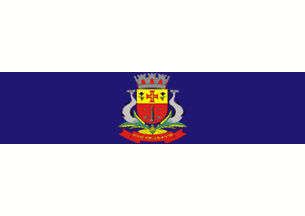 image by Dirk Schönberger,
13 October 2012
image by Dirk Schönberger,
13 October 2012Source: http://www.portal.caraguatatuba.sp.gov.br/caragua_conteudo.php?id=88

Last modified: 2012-11-10 by ian macdonald
Keywords: sao paulo | caraguatatuba |
Links: FOTW homepage |
search |
disclaimer and copyright |
write us |
mirrors
 image by Dirk Schönberger,
13 October 2012
image by Dirk Schönberger,
13 October 2012
Source:
http://www.portal.caraguatatuba.sp.gov.br/caragua_conteudo.php?id=88
A horizontal triband, white-blue-white, with the municipal arms in the centre.
Official website at
http://www.portal.caraguatatuba.sp.gov.br
Dirk Schönberger,
13 October 2012
Caraguatatuba was founded in 1664/1665, as Santo Antônio de Caraguatatuba, by Manuel de Faria Dória, Captain of the Captaincy of Itanhaém. An epidemic of small-pox nearly suppressed the town in 1693; the survivors moved to Ubatuba and São Sebastião, so that the place was known as the Deserted Town. Progressively resettled, the place was noticed by Luiz Antônio de Souza Botelho Mourão Morgado de Mateus, Captain General of the Captaincy of São Paulo, who rehabilitated on 27 September 1770 the town of Santo Antônio de Caraguatatuba. The parish of Santo Antônio de Caraguatatuba was established on 16 March 1847 by Law no. 18. On 20 April 1857, Santo Antônio de Caraguatatuba was made a municipality, seceding from São Sebastião. In 1910, Caraguatatuba counted only 3,562 inhabitants; in 1927, it was still a fisher's village with a single beach and hardly two streets. The establishment the same year by the French J. Charvolin, owner since 1916 of the Société Française pour l’exploitation et le commerce de Bois Exotiques, of the English Estate boosted the development of the town. In the 1940s, Caraguatatuba emerged as a recreational area. The town was awarded the title of Sea Resort on 30 November 1947 by Law No. 38. On 18 March 1867, a landslide form the Serra do Mar, caused by heavy storms, claimed more than 100 lives and displaced another 3,000 out of the 15,000 people living in the town.
The flag of Caraguatatuba is prescribed by Municipal Law No. 381, adopted in 1960. The flag is horizontally divided white-blue-white with the municipal coat of arms in the middle. The stripes represent "the ethnic elements of the population".
Photo of the flag:
http://caraguatur.wordpress.com/2012/06/06/caraguatatubenses-surfam-ondas-gigantes-no-peru/luciano-santanna-tom-pool-e-allan-guerra-com-a-bandeira-caraguatatubense-foto-mirim-ujyio
http://www.caraguatatuba.sp.gov.br/noticias/?id=5536
http://www.fundacc.com.br/ver_news.asp?id=876
http://www.al.sp.gov.br/StaticFile/noticia/agencia/foto_grande/11-2008/Afonso%20Lobato%20(centro),%20presidente%20da%20Frente%20parlamentar,%20em%20Caraguatatuba.jpg
[On the photos, the blue shade of the flag appears to be lighter than on the images, close to the blue shade of the Brazilian flag.]
The coat of arms of Caraguatatuba is prescribed by Municipal Law No. 501, adopted in 1995. "Gules two arrows argent crossed per saltire behind an anchor of the same. A chief or a Cross of the Order of Christ surrounded by two lilies azure. The shield surmounted by an eight-towered mural crown argent ports gules. The shield supported dexter and sinister by a dolphin. Below the shield a pine apple surrounded by banana fruits and leaves all proper. A scroll gules inscribed with the motto "DVC IN ALTVM" in letters or.
The Iberic shield highlights the influence of the Portuguese and Spanish colonists, who constituted, together with the natives, our nation. The eight-towered mural crown represents the seat of a "comarca". The open gates represents hospitality; moreover, red is, in Brazil, the colour of Law and Justice. The arrows symbolize the natives, while the anchor symbolize the town as a beach resort. The anchor also means firmness, safety and hope, characteristic of a municipality with environmental resources and a fertile soil that will progressively made of it one of the most estimated tourist's spots in São Paulo State and in Brazil. Gules (red) means patriotic love, dedication, audacity, intrepidity, courage, valiance and justice, expressed by the people of Caraguatatuba. The cross symbolizes the Christian faith of the inhabitants. The lilies represent the devotion to St. Anthony, the patron saint of the town. The name of the early parish of Santo Antônio de Caraguatatuba emphasized the devotion for the Lisbon saint. The dolphins represents the sea and the tourist's potential represented by fishing. Bananas and, to a lesser extent, pineapples, are the main crops in the municipality. The motto comes from the episode of the miraculous catch of fish in the Gospel of Luke ["Put out into deep water" - Luke, 5:4]; it is used by the municipality as a paradigm of its accelerated ascension to a marvelous future.
The today's coat of arms superseded the first coat of arms of
Caraguatatuba, prescribed in 1957 by Municipal Law No. 260.
The supporters and scroll seem to have remained unchanged. The chief
seems to have been charged with a Maltese cross azure superimposed
with a lily argent. The anchor was superimposed an escutcheon
representing the town of Lisbon.
Ivan Sache, 3 November 2012